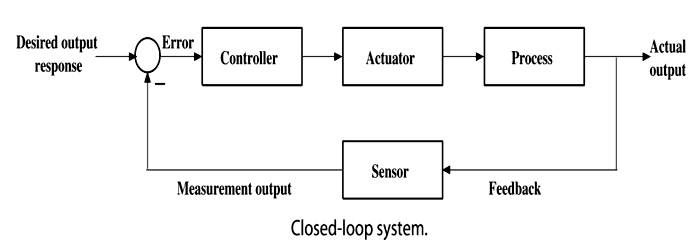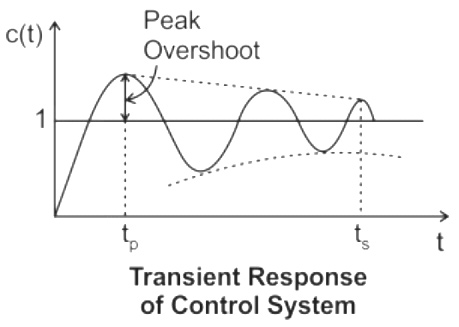The transient response, with feedback system
Right Answer is:
Decays quickly
SOLUTION
The transient response, with feedback system decays quickly.
Closed-Loop Control
- A closed-loop control system utilizes a measure of the actual output to compare the actual output with the desired output response.
- The measure of the output is called the feedback signal. The elements of a general closed-loop feedback control system are shown in Figure.

- A closed-loop control system compares the measurement of the output with the desired output (reference or command input).
- The difference between the two quantities (the error signal) is then used to drive the output closer to the reference input through the controller and actuator.
- Often the difference between the output of the process under control and the reference input is amplified and used to control the process so that the difference is continually reduced.
Transient Response
After applying an input to the control system, the output takes a certain time to reach a steady state. So, the output will be in a transient state till it goes to a steady-state. Therefore, the response of the control system during the transient state is known as the transient response.

Settling time:
It is time required for the response to use and reach to the tolerance band.
For 2% tolerance band:
${t_s} = 4\tau = \frac{4}{{\xi \:{\omega _n}}}$
For 5% tolerance band:
${t_s} = 4\tau = \frac{3}{{\xi \:{\omega _n}}}$
Thus due to negative feedback transient responses decay very fast.
Advantages of closed-loop Systems
Closed-loop systems have the following advantages:
- Faster response to an input signal.
- Effective disturbance rejection
- Better tracking of references
- Low sensitivity to system parameter errors (e.g., errors in plant or controller gains)
- Low sensitivity to changes in calibration errors (recalibration is unnecessary)
- More accurate control of plants under disturbances and internal variations.
- Effective and flexible control tuning by varying the control gain is used to stabilize systems that are inherently unstable in the open-loop form.
- These systems have high bandwidth i.e., high operating frequency zone than the open-loop system.
- The transient response in the closed-loop system decays more quickly than in the open-loop system.
The feedback reduces the time constant, lesser the time constant faster the response. Hence the transient response decay more quickly.
